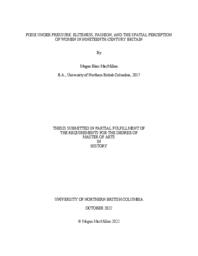Mattfeld, Monica
Person Preferred Name
Monica Mattfeld
Related Works
Content type
Digital Document
Description / Synopsis
Every summer thousands of Britain’s elite upper class travelled to London’s West End to socialize and participate in the Season. During this time, elite women donned luxurious court gowns and went to St. James Palace to present themselves before Queen Victoria in Drawing Room ceremonies. One of these gowns, from 1863, survives today and offers an evocative glimpse of how elite women styled themselves for one of the most important ceremonies in their life. But, the West End was not just an elite neighbourhood. It also housed and employed middle and working-class Victorians with whom the elite did not always happily coexist. In 1861, peer and M.P. Sir Shelley allegedly flashed the public and his middle-class neighbours while a carriage procession for one of the Queen’s Drawing Room ceremonies passed below. The Times reported his trial, which featured contemptuous cross-examinations of several working-class women, and Sir Shelley’s triumphant victory. Two years later, several elite men submitted letters to the editor of The Times, complaining about the cramped and sometimes combative atmosphere of royal ceremonies, suggesting that they were not safe for women to attend. There is a gendered conflict in these sources. Those from elite feminine perspectives show the value in attending royal ceremonies, during which women could use their fashion and occupation of space to reinforce or manipulate their social status. The documents written from men’s points of view, however, show an attempted renegotiation of elite status by excluding the middle class and further limiting women’s access to elite spaces. My research questions where this conflict originated and how historians can utilize less traditional sources to bring feminine perspectives into areas of history in which male points of view have often dominated.
Origin Information
Content type
Digital Document
Description / Synopsis
In literature and film, werewolves have gone through an incredibly varied series of portrayals, but, throughout all of their changes (cycling largely between being antagonists and protagonists), werewolves have always interacted with the essentialist concept of the human-animal binary. Mutable at their core, werewolves reflect the people, places, and times of their various manifestations; the werewolf is whatever we need it to be. The fact that werewolves are inherently liminal creatures means that, for the purposes of my thesis' discussion, werewolves can serve as a tool for addressing preconceived notions of human exceptionalism (i.e., anthropocentrism). I question the assumptions of boundaries and socalled human traits with a story about embracing the uncertainty that our classifications and labels seek to efface. Simultaneously, I draw attention to female werewolves to level a concurrent challenge against patriarchal scripts that denigrate the association of human females with non-human animals. Just as many historical portrayals of werewolves reinforce the negative connotations of a woman-animal alignment, so too do contemporary representations of female werewolves become subject to portrayals that reinforce patriarchal values, rather than challenge them. Therefore, my focus is two-fold: to present an alternative narrative (in the form of a theory piece married to a novel) that draws attention to the artificial nature of both anthropocentrism and androcentrism. These two ways of thinking—that humans are inherently more important than animals and that the perspectives of male humans, in particular, trump all other points of view—are inextricably linked in their ideological othering of alternative experiences of being. The female werewolf, an embodiment of both inferior entities, is a well-suited symbol to decentralize dominant patriarchal narratives. Presented herein is my theory piece and the first fifteen chapters of my novel, Then, We Were Wolves, Again. It is a story about a woman who becomes the wolf she was all along and a man who undergoes a transformation but does not change. As a human, the protagonist, Harley, drifted through life like a lone wolf, but now, as an actual werewolf, she struggles to reconcile her instinctual need for her pack with her growing sense of disenchantment with her fellow lycanthropes. Indoctrinated by their leader, Arden, they're convinced of their sovereignty as a superior species to humans, but this new werewolf picks away at the cracks of hypocrisy, revealing the same species-centric thinking the wolves claim to transcend.
Origin Information
Content type
Digital Document
Description / Synopsis
British Columbia has the largest grizzly bear population in Canada. In 2017, B.C. banned the hunt of grizzly bears citing a lack of societal support, despite government-cited science that the hunt was sustainably managed. I explored the factors that influenced popular perceptions of grizzly bears, the hunt, how these factors may have influenced the province’s decision to implement the ban, and its reception by various actors. Methods included: examining key claims in government documents preceding the ban; surveying media coverage of the ban; and interviewing experts (n = 30) about their role in, and opinion of the ban. Results indicated that public perception of the hunt, and its framing as a trophy hunt outweighed scientific evidence of hunt sustainability. However, controversy over the representativeness of the “public opinion”, and comprehensiveness of government consultation processes remain. I suggest avenues for further research into roles of social values in natural resource policy.
Origin Information



